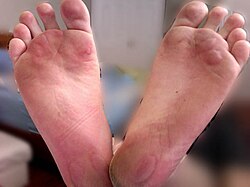Blister
| Blister | |
|---|---|
A blister is a small pocket of
The word "blister" entered English in the 14th century. It came from the
To heal properly, a blister should not be popped unless medically necessary. If popped, bacteria can enter. The excess skin should not be removed because the skin underneath needs the top layer to heal properly.[2]
Causes

A blister may form when the skin has been damaged by
Friction
Intense rubbing can cause a blister, as can any friction on the skin if continued long enough. This kind of blister is most common after walking long distances or by wearing old or poorly fitting shoes.
Burning
This type of blistering is one of the tools used to determine the
Blisters can also form on the hands and feet as a result of tissue damage incurred by frostbite.[7]
Chemical exposure
Sometimes, the skin will blister when it comes into contact with a cosmetic, detergent, solvent, or other chemical such as
Blood blister
A blood blister usually forms when a minute blood vessel close to the surface of the skin ruptures (breaks), and blood leaks into a tear between the layers of skin. This can happen if the skin is crushed, pinched or aggressively squeezed.
Medical conditions
There are also a number of medical conditions that cause blisters. The most common are
- Bullous pemphigoid: a skin disease that causes large, tightly filled blisters to develop, usually affecting people over the age of 60.
- Pemphigus: a serious skin disease in which blisters develop if pressure is applied to the skin; the blisters burst easily, leaving raw areas that can become infected.
- Dermatitis herpetiformis: a skin disease that causes intensely itchy blisters, usually on the elbows, knees, back and buttocks. The blisters usually develop in patches of the same shape and size on both sides of the body.
- Chronic bullous dermatosis: a disease that causes clusters of blisters on the face, mouth or genitals.
- Cutaneous radiation syndrome
- Epidermolysis bullosa:[10] a genetic disorder that results in a detachment in the skin layers, resulting in easy bruising.
Pathophysiology
Friction blisters
Friction blisters are caused by excess shear stress between the bottom and surface of the skin and the body. The strata of skin around the stratum spinosum are most susceptible to shear. As the stratum spinosum tears away from the connecting tissues below, plasma from the cells diffuses out. This plasma solution helps new cells divide and grow into new connective tissues and epidermal layers.
The clear fluid will be reabsorbed as new cells develop and the swollen appearance will subside. Painful blisters located on hands (palmar surface) and feet (plantar surface) are due to tissue shearing deeper in the epidermis, near nerve endings. Lower tissues are more susceptible to infection.
Prevention
Friction blisters
Friction blisters, caused by rubbing against the skin, can be prevented by reducing the friction to a level where blisters will not form.[3][4][5][11] This can be accomplished in a variety of ways.
Blisters on the feet can be prevented by wearing comfortable, well-fitting
Even before a "hot" or irritated area on the foot is felt, taping a protective layer of padding or a friction-reducing interface between the affected area and the footwear can prevent the formation of a blister.
To avoid friction blisters on the hands, gloves should be worn when using tools such as a shovel or pickaxe, doing manual work such as gardening, or using sports equipment like golf clubs or baseball bats. Oars used for competitive rowing are known for causing frequent blisters on the hands of oarsmen. Weightlifters are also prone to blisters as are gymnasts from the friction developed by the rubbing against the bars. To further reduce the occurrence one can tape the hands, and there are also a number of products on the market that claim to reduce the occurrence of blisters. These are all intended to be worn as a liner underneath a glove. The majority of these offerings simply add padding, and create a layer that reduces the coefficient of friction between the skin and the glove.
A
Other
Sunscreen and protective clothing should also be used during the hottest part of the day to avoid blisters from sunburn. Avoiding sunlight during midday is the best way to avoid blisters from sunburn. Protective gloves should be worn when handling detergents, cleaning products, solvents and other chemicals.
References
- PMID 3358612.
- ^ "Should you pop a blister? When to do it, safe methods, and tips". www.medicalnewstoday.com. 2019-07-29. Retrieved 2022-10-14.
- ^ a b [Naylor PFD. "The Skin Surface and Friction," British Journal of Dermatology. 1955;67:239–248.]
- ^ a b [Naylor PFD. "Experimental Friction Blisters," British Journal of Dermatology. 1955;67:327–342.]
- ^ a b [Sulzberger MB, Cortese TA, Fishman L, Wiley HS. "Studies on Blisters Produced by Friction," Journal of Investigative Dermatology. 1966;47:456–465.]
- ^ [Carlson JM. "The Friction Factor," OrthoKinetic Review. Nov/Dec 2001;1(7):1–3.]
- ^ "First Degree Burns". Uuhsc.utah.edu. Archived from the original on 2012-02-18. Retrieved 2012-02-21.
- ISBN 9781437735727.
- ^ Commissioner, Office of the (2 December 2021). "Consumer Updates - Outsmarting Poison Ivy and Other Poisonous Plants". www.fda.gov.
- S2CID 221861310.
- ^ [Hanna T, Carlson JM. "Freedom from Friction," OrthoKinetic Review. Mar/Apr 2004;4(2):34–35.]
- ^ "Treatment Skin Blisters – Blister On Bottom Of Foot – Blister On Foot". Goengo.com. Archived from the original on 2012-03-12. Retrieved 2012-02-21.
- ^ "Adventure Medical Kit Blister Medic Gel - BackpackGearTest.org". backpackgeartest.org.
